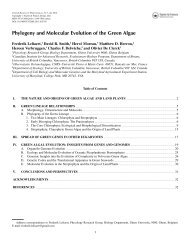" ;-~~'fJJ,~:L", BAN DA"~' - Phycology Research Group, Ghent ...
" ;-~~'fJJ,~:L", BAN DA"~' - Phycology Research Group, Ghent ...
" ;-~~'fJJ,~:L", BAN DA"~' - Phycology Research Group, Ghent ...
Create successful ePaper yourself
Turn your PDF publications into a flip-book with our unique Google optimized e-Paper software.
140 BLUMBA - VOL. 34, No.1, 1989Udotea orientalis Gepp & Gepp - Plate 10, figs. 11-16Plants greyish green, rather thick and somewhat stiff. Fixation by a more or lessbulbous group of rhizoids (fig. 13). Stipe simple, 1-2 cm high, 1-2 mm thick, corticated;blade flabellate, mostly with cordate to auriculate base (figs. 11-13),2-3 cmin diameter, sometimes proliferous at the upper margin (fig. 13), surface longitudinallyfilamentous-striate, markedly zonated, pluristromatic. Frond filaments (27-)30(-35) !lm in diameter, dichotomous, supradichotomic constrictions very unequallysituated (figs. 14-16), smooth, without lateral branchlets or appendages, closelyinterwoven in several layers, conglutinated by the calcification.Specimens examined. SN 10281 A: st. 4.030, Tukang Besi Is., Wcoast Binongko, reef slope, till c. 20 m deep; SN 10296 A: st. 4.030, Tukang BesiIs., W coast Binongko, reef flat; SN 11034 A, E: st. 4.123, N of Sumbawa, Bay ofSanggar; SN 11510 A: st. 4.161, SW Salayer, reef crest; SN 11544 A, E: st. 4.161,SW Salayer, sandy reef flat; SN 11615 A, E: st. 4.158, SW Salayer, near Cape BatuKerapo, sheltered bay.Geographic distribution. Indo-Pacific.Dis c us s ion. Agreeing with Gepp & Gepp's description (1911: 119) in allcharacters.IDENTIFICATION KEY OF THE CAULERPALES(except Caulerpa, Halimeda)This key of the Caulerpales from the Snellius-II expedition comprises all species of this grouprecorded from Indonesia (Gepp & Gepp, 1911; Taylor, 1966; Weber-van Bosse, 1913), except theseldomly recorded Boodleopsis siphonacea Gepp & Gepp, Penicillus nodulosus Blainville, P. sibogaeGepp & Gepp, Udotea explanata Gepp & Gepp, and U. papillosa Gepp & Gepp. These fivespecies are not known to occur in the Philippines (Silva et aI., 1987), or, except the two Penicillusspecies, in Northern Australia (Lewis, 1987).1a. Thallus composed of free filan1ents . . . . . . . . . . . . . . . . . . . . . . . . .. 2b. Thallus composed of intricated or conglutinated filaments . . . . . . . . . " 42a. Thallus composed of a monosiphonous axis provided with glomeruli (verticilsof mainly dichotomously branching filaments) ... Tydemania expeditionisb. No main axis, no verticils, all erect filaments alike Chlorodesmis 33a. Supporting segment of the dichotomy convex (not truncated), supradichotomicconstrictions very unequally situatedChlorodesmis fastigiatab. Supporting segment of the dichotomy truncated, supradichotomic constrictionsat same level Chlorodesmis hiIdenbrandtii4a. Thallus calcified. . . . . . . . . . . . . . . . . . . . . . . . . . . . . . . . . . . . . .. 5b. Thallus not calcified . . . . . . . . . . . . . . . . . . . . . . . . . . . . . . . . . . . .. 10Sa. Thallus composed of a monosiphonous axis provided with glomeruli (verticilsof mainly dichotomously branching filaments) ., Tydemania expeditionisb. Thallus composed of a stipitate blade. . . . . . . . . . . . . . . . . . . . . . . .. 66a. Blade filaments without appendages . . . . . . . . . . . . . . .. 7b. Blade filaments with appendages 9
















